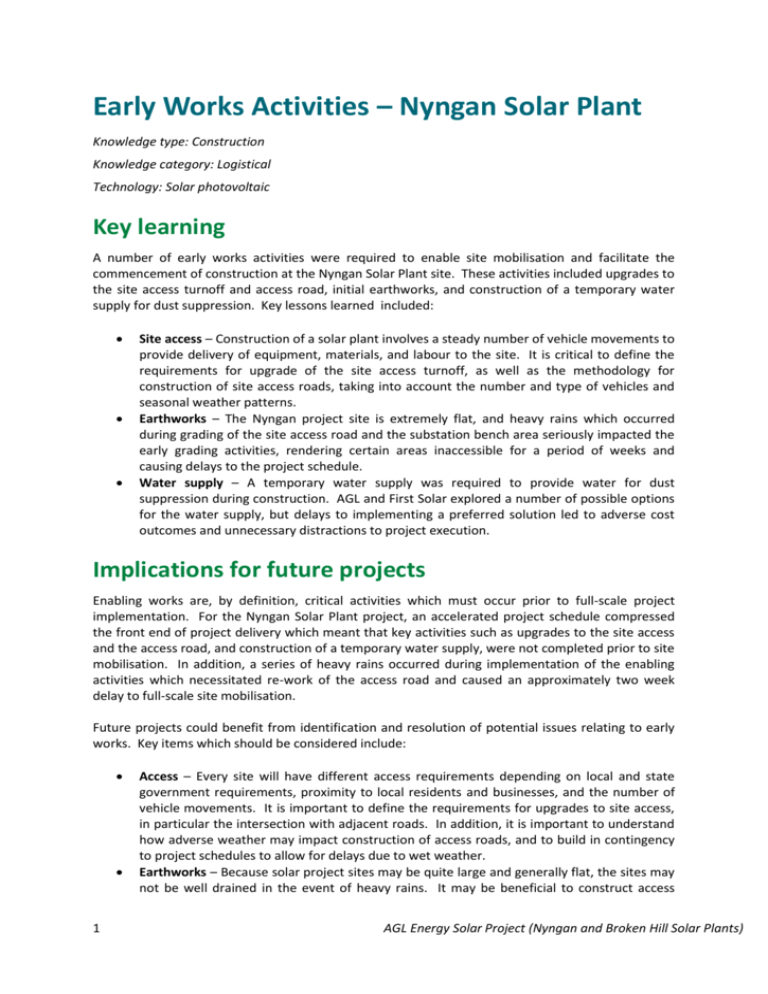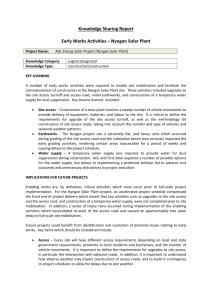DOC 27KB
advertisement

Early Works Activities – Nyngan Solar Plant Knowledge type: Construction Knowledge category: Logistical Technology: Solar photovoltaic Key learning A number of early works activities were required to enable site mobilisation and facilitate the commencement of construction at the Nyngan Solar Plant site. These activities included upgrades to the site access turnoff and access road, initial earthworks, and construction of a temporary water supply for dust suppression. Key lessons learned included: Site access – Construction of a solar plant involves a steady number of vehicle movements to provide delivery of equipment, materials, and labour to the site. It is critical to define the requirements for upgrade of the site access turnoff, as well as the methodology for construction of site access roads, taking into account the number and type of vehicles and seasonal weather patterns. Earthworks – The Nyngan project site is extremely flat, and heavy rains which occurred during grading of the site access road and the substation bench area seriously impacted the early grading activities, rendering certain areas inaccessible for a period of weeks and causing delays to the project schedule. Water supply – A temporary water supply was required to provide water for dust suppression during construction. AGL and First Solar explored a number of possible options for the water supply, but delays to implementing a preferred solution led to adverse cost outcomes and unnecessary distractions to project execution. Implications for future projects Enabling works are, by definition, critical activities which must occur prior to full-scale project implementation. For the Nyngan Solar Plant project, an accelerated project schedule compressed the front end of project delivery which meant that key activities such as upgrades to the site access and the access road, and construction of a temporary water supply, were not completed prior to site mobilisation. In addition, a series of heavy rains occurred during implementation of the enabling activities which necessitated re-work of the access road and caused an approximately two week delay to full-scale site mobilisation. Future projects could benefit from identification and resolution of potential issues relating to early works. Key items which should be considered include: 1 Access – Every site will have different access requirements depending on local and state government requirements, proximity to local residents and businesses, and the number of vehicle movements. It is important to define the requirements for upgrades to site access, in particular the intersection with adjacent roads. In addition, it is important to understand how adverse weather may impact construction of access roads, and to build in contingency to project schedules to allow for delays due to wet weather. Earthworks – Because solar project sites may be quite large and generally flat, the sites may not be well drained in the event of heavy rains. It may be beneficial to construct access AGL Energy Solar Project (Nyngan and Broken Hill Solar Plants) roads progressively, such that vegetation removal and ground disturbance is minimised over wide areas and construction is constrained to discrete sections which can be started and finished before moving on to adjacent areas. It is also important to understand how site earthworks may impact drainage towards neighbouring properties and adjacent roads. Water Supply – Depending on site location and local water availability, it may be difficult and/or expensive to supply water for dust suppression during project construction. It is important to consider the various options for supplying/storing water to the site (pipeline, site dam/tanks, water trucks) and the costs and implications of each option. It is important to carefully estimate the amount of water which could be required in the event of prolonged hot and dry conditions, taking into account the area of which construction activities are being conducted. It is also important to consider community concerns around the use of water for dust suppression as opposed to irrigation. Knowledge gap There is no real knowledge gap concerning enabling works, considering that many of these issues would be typical to any large-scale construction project. However, experience with construction of utility-scale solar projects is fairly limited in Australia, and regulators and contractors may not be aware of how these issues may affect delivery (in terms of cost and schedule) of a solar energy project. For the Nyngan project, the specification and negotiation of requirements for highway access upgrades was challenging, based in part on uncertainty around the number and duration of vehicle movements to the site. Background Objectives or project requirements To enable site mobilisation for the contractors engaged to deliver the solar plant and the substation and transmission line, it was critical for AGL and First Solar to undertake some early activities prior to full-scale mobilisation. Upgrades to the site access were required by the local Council and NSW Roads & Maritime Services (RMS) to ensure the safety of traffic flows along the Barrier Highway. Construction of an access road from the highway to the project site was also critical to enable vehicle movements to the site, including deliveries of equipment required to construct the substation and transmission line. In addition, it was essential to identify and implement a preferred solution for delivery of water for dust suppression during construction. Process undertaken AGL engaged a local contractor to construct the rural site access to enable vehicles to safely enter and exit the site, and to construct a security gate to control access to the project site. Future work will involve construction of a more developed intersection and turning lane from the Barrier Highway. AGL engaged First Solar to construct the site access road from the highway to the project site, and First Solar in turn engaged an Australian civil contractor to build the road. Construction of the access road was impacted by heavy rains which prevented movement of vehicles and caused an approximately two week delay to road construction and, in turn, the overall project schedule. In addition, due to the very flat topography, the site does not drain well and ponds develop in low spots which has necessitated additional works to improve drainage in certain areas. 2 AGL Energy Solar Project (Nyngan and Broken Hill Solar Plants) AGL and First Solar investigated a number of options for water supply to the site, including accessing water from the nearby Cobar Water Pipeline, pumping water from the weir at Nyngan, or trucking water from the Council depot at Nyngan. Each option had advantages and disadvantages in terms of cost and infrastructure required, as well as the type of water and the need for acquisition of water rights. First Solar ultimately arranged to purchase water from a nearby landowner with water rights, and to install additional pipe required to deliver the water to the site. 3 AGL Energy Solar Project (Nyngan and Broken Hill Solar Plants)






